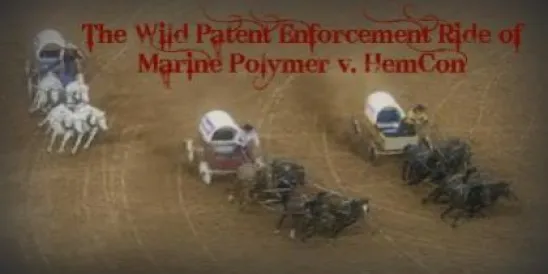Problems arise when you suddenly realize that you have prepared for one type of race and you find yourself in the middle of a completely different type of competition. Those involved in patent infringement cases analogize the process to running a marathon. Marine Polymer Technologies (Marine Polymer) and HemCon Medical (HemCon) prepared for a marathon; however, they instead found themselves for most of 2011 until March of this year in something akin to a wild chuck-wagon race at the Federal Circuit rodeo roundup.1
The two companies are pushing, jostling and jockeying their horse teams over the right to practice a biomedical polymer technology useful to promote hemostasis, which is used to stop bleeding. Marine Polymer received a patent on this biomedical polymer technology in 2005 bearing 22 claims.2 The focus of much of the dispute relates to two matters: 1) the meaning of the term "biocompatible", which all the claims either use or reference; and 2) whether intervening rights arise in claims that are not amended during reexamination but the scope of which is possibly narrowed through reexamination argument.
The Federal Circuit in a split en banc "in the alternative" decision suggests no intervening rights arise unless the claims are amended during reexamination. Numerous patent holders became concerned about some of the earlier court decisions during this chuck-wagon race, which likely would have significantly increased the number of requests for reexamination filings by third parties, causing concern about changing claim scope. Now, most patent holders are breathing a sigh of relief as Marine Polymer nosed out HemCon at the last Federal Circuit wagon race.
Yeee-haw! Let's Ride!!!
HemCon and Marine Polymer ran several races against one another before arriving at the big show. Marine Polymer sued HemCon for patent infringement in in the U.S. District Court of New Hampshire in 2006. During this first race, HemCon shot the ex parte reexamination start gun and forced Marine Polymer to run a second, concurrent heat at the Patent and Trademark Office track.
Outside observers often have a difficult time telling who is winning a chuck-wagon race until the very end, and it is no different here. In 2008, the District Court's Markman construction narrowly defined the term "biocompatible" to reflect the description given in an example detailed in its patent.3 During reexamination, the Examiner initially adopted the "broadest reasonable interpretation"4 of "biocompatible", disagreed with the District Court's construction due to several dependent claims in the original '245 patent, and rejected all the claims as invalid. Seeing potential victory in both races suddenly in jeopardy, Marine Polymer quickly jettisoned six of the claims from the original '245 patent that were slowing their team down. The six claims hindered their argument to the Examiner for adopting the District Court's "biocompatible" construction. After lightening their load, the Examiner finally agreed with the District Court's construction without requiring any amendment to the remaining 16 claims.
After traversing the PTO racetrack, Marine Polymer drove its team as hard as it could. Marine Polymer won the District Court race in late 2010, taking a prize purse containing $29 million in reasonable royalty damages and a permanent injunction over HemCon.5 Marine Polymer's second win garnered it a reexamination certificate for its '245 patent, the reexamined '245 patent having six fewer claims than the original '245 patent, in early 2011.6
At the Federal Circuit rodeo roundup, however, HemCon bolted off the line and never looked back, claiming intervening rights under 35 U.S.C. § 252.7 HemCon argued that Marine Polymer narrowed the scope of the '245 patent claims when it adopted the District Court's claim construction of "biocompatible" during reexamination.
HemCon took the victory in the first Federal Circuit race with a 2-1 decision and rode off with the damages and injunction prizes in tow. The majority opinion in this first Federal Circuit decision states that the District Court's "biocompatible" term construction is incorrect in light of the claims of the original '245 patent. Because the term construction is wrong, adopting the term during reexamination obviously changed the scope of the remaining claims for the reexamined '245 patent from their original scope. The opinion found that changing the scope of patent claims during reexamination is simply an unfair way to win a race, even though the words of the claim did not change. Therefore, the court granted HemCon victory through a new type of equitable intervening right based upon only argument during reexamination: amendment to a claim by "disavowal or estoppel".8
A new and much more difficult racecourse for all patent owners appeared when the dust cleared. Based on this decision, if reexamination occurs at any point in the patent's lifetime - whether there are amendments to the text of the claims or not - the other race contestant can assert intervening rights based upon mere arguments made during reexamination as a change to the scope of the claims. As HemCon did here, an opposing party can initiate the very reexamination process that fosters the potential arguments for the new equitable intervention right! Cowpokes started looking around at the agitated patents roaming their ranches and seeing potential stampedes everywhere.
The en banc Federal Circuit, not taking too kindly to the sudden racecourse redesign and sensing many spooked and ornery patent holders out there, quickly halted this new contest.9 During the "do over" race in front of the en banc court, the majority straightened out all the contestants: there first must be textual amendments to the reexamined claims before a challenger can argue for intervening rights, and that arguments made during reexamination are not amendments to the claims text.10 With that, the Marine Polymer team cleared the finish line by a nose and reclaimed its prizes at the end of the en banc race.
Future Considerations for Patent-type Cowpokes
A major lesson from these rambunctious series of rides is that there are no intervening rights due to possible reinterpretations of the scope of reexamined claims unless there are amendments to the claims. The claim language must be modified to be "amended" for purposes of both 35 U.S.C.§ 307 ex parte and § 316 inter partes reexamination intervening rights. The en banc majority states that "amend" has its ordinary and traditional meaning.
Another major lesson is that using language to identify "the invention" in the specification of a patent risks narrowing the scope of claim term meaning. The District Court specifically identified the phrase "of the invention" in Marine Polymer’s patent and used the language around the term to interpret "biocompatible". Marine Polymer had to run several races, including reexamination, with the District Court's construction. Even though it appears that Marine Polymer won the last race, the claims of the reexamined '245 patent, with the District Court's construction firmly imbedded, perhaps are narrower in scope than what it initially had obtained.
On the other hand, did Marine Polymer win the final race? We may soon find out if there are a few more laps to go. The en banc court's highly unusual "in the alternative" decision - split 5-5 on the meaning of the "biocompatible" claim term and 6-4 on the issue of intervening rights - may tempt HemCon into provoking another race out of Marine Polymer, but this time at the biggest rodeo of them all: the U.S. Supreme Court.
_______________________________________________
1 For those unfamiliar with western-styled rodeos such as The Houston Livestock & Rodeo, chuck-wagon races are Ben-Hur-esque events where 4-horse teams connected to tiny wagons with a driver race around a very short track a few times. Wheels sometimes fly off the wagons. The teams occasionally throw drivers. Crowds love it. See, e.g., http://www.youtube.com/watch?v=GeRW8_BDQME ("Houston Rodeo 2012") (uploaded March 12, 2012).
2 U.S. Patent No. 6,864,245, "Biocompatible Poly-β-1→4-N-Acetylglucosamie" (issued March 8, 2005) [hereinafter "the original '245 patent"].This is quite useful for injured chuck-wagon drivers.
3 Marine Polymer Technologies, Inc. v. HemCon, Inc., No. 06-CV-100-JD, 2008 WL 19952454, at *3, *10 (D.N.H. May 6, 2008) (Markman decision) (Example 10).
4 United States Patent and Trademark Office, Manual of Patent Examining Procedure § 2258.I.G at 2200-94 (8th ed., rev. 7, July 2008) (Claim Interpretation and Treatment) ("uring reexamination, claims are given the broadest reasonable interpretation consistent with the specification and limitations in the specification are not read into the claims." Id.).
5 Marine Polymer Technologies, Inc. v. HemCon, Inc., 659 F.3d 1084, 1089 (Fed. Cir. 2011), vacated, Marine Polymer Technologies, Inc. v. HemCon, Inc., No. 2010-1548 (Fed. Cir. Jan. 20, 2012) (per curium) (vacating Sept. 26th panel decision; granting en banc review) (slip order) [hereinafter “Panel Decision”].
6 Ex Parte Reexamination Certificate (8124), U.S. Patent No. 6,864,245 (issued March 29, 2011) [hereinafter "the reexamined '245 patent"].
7 35 U.S.C. § 252 (1999).
8 Panel Decision, 659 F.3d at 1093.
9 Marine Polymer Technologies, Inc. v. HemCon, Inc., No. 2010-1548 (Fed. Cir. Jan. 20, 2012) (per curium) (vacating Sept. 26th panel decision; granting en banc review) (slip order).
10 Marine Polymer Technologies, Inc. v. HemCon, Inc., No. 2010-1548, at 21-23 (Fed. Cir. March 15, 2012) (en banc) (slip opinion).



 />i
/>i

